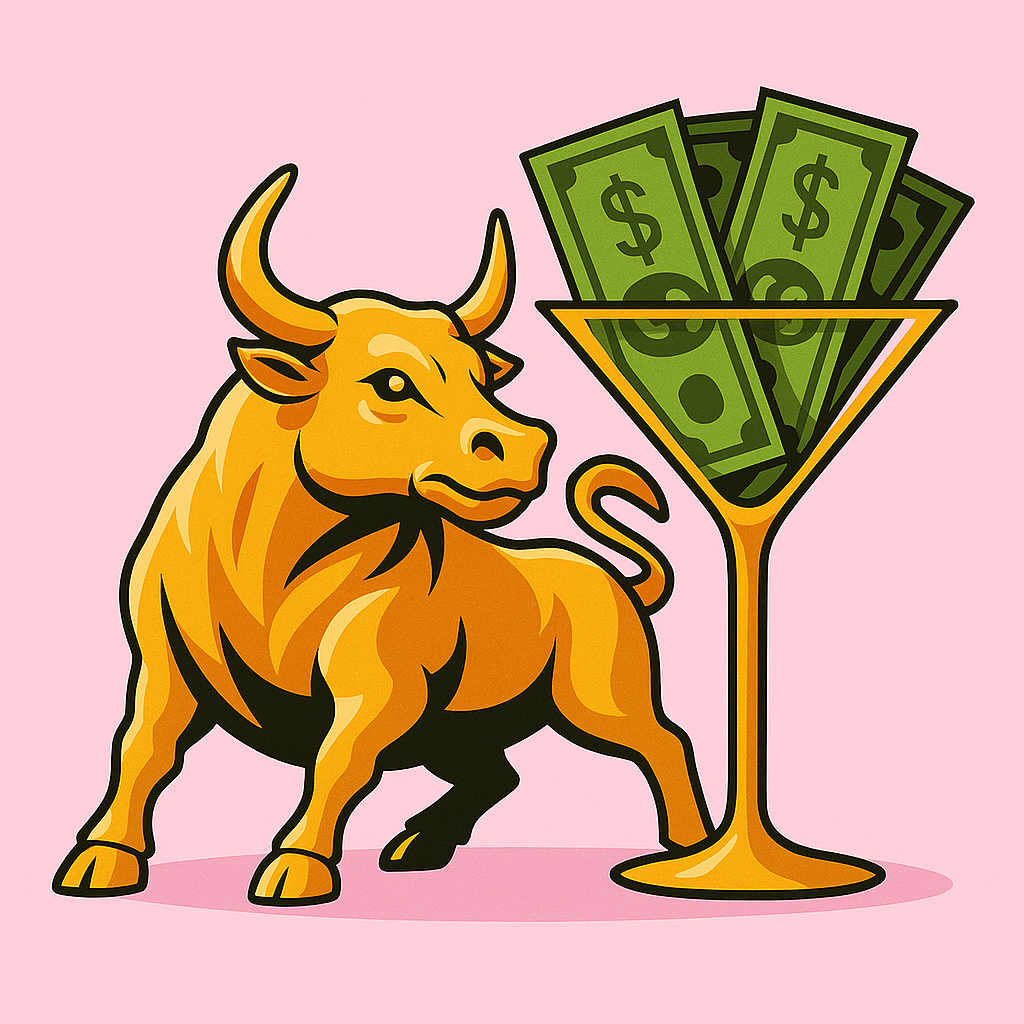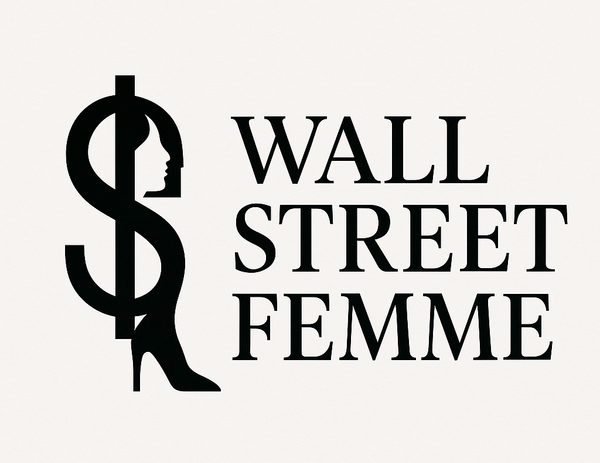Finance Beyond the Bull: Because Money Doesn’t Have to Be Boring

After living in NYC for about 2 years now, I can say that I have come across many different genus of New Yorker. A particularly interesting one for starters is “The Finance Bro”. Think Patagonia vests, Cole Haan shoes, and most importantly, a strong opinion about the Fed’s interest rate decisions. Somewhere in the conversation while flashing his new Patek Philippe, he drops the magic words: “Portfolio diversification is key” indirectly stating that he is not looking for anything serious—and he thinks that just because you are a woman, you won’t understand what he means. While you can roll your eyes and say “Sure diversification is smart but if I had invested my entire net worth in NVIDIA before the AI Boom I would say my ROI would be significant, same thing goes for me” but instead you choose to leave him with a $500 bill because you don’t like his attitude, so you lean in and say “Ohh, how diverse would you want your portfolio to be, I wanna hear it alllll” and then make an Irish exit.
Here’s the thing: investing is not just for grandpas with exclusive golf club memberships or dudes with LinkedIn Premium. It’s for you and me and everyone else who is sick and tired of being left out of the money conversation. Money, believe it or not, is for all of us, not just the Patagonia vest wearers.
May I take the liberty of assuming that if you are reading this, you are potentially an avid reader who also reserves time to keep up with the news. If so, you are familiar with the terms “equity”, “acquisitions”, “leverage”, “capital”, “yield curve” etc. and maybe thought that this is not your thing. Well, let me break down the fancy Wall Street jargon for you so the next time you go on a date with a man in finance, you might be more able to provide him with a more humbling experience:
Stocks: You go to Sephora and you buy a Rare Beauty Blush. This is one portion of the entire inventory of Rare Beauty—so you essentially now own a share. The same thing goes for companies. As I am writing this, Apple’s stock price has gone down by 1.08% from yesterday (not good) and is currently worth $200.63 per share. If you bought yesterday, you’ve lost money. If it goes up tomorrow by 2%, congrats, you made a smart investment. At the end of a year you might get your money back, be the recipient of a dividend or show a capital gain if the share price moves up to say $250. It’s all a bit of risk, but look at stocks over the last 5 years/ 10 or 20 years… The stock market is a roller coaster with ups and downs but in general “The only way is up”.
Dividends: The company’s goal is to make money (it isn’t called business for nothing), and at the end of the year or business quarter, if the business you are now a shareholder of decides to pay dividends, it means it wants to share some of its profits with you. This is not an act of kindness or generosity—it’s what makes you stick around, and dividends are often paid in shares, so the cash goes straight back into the company. The larger the business, the more the revenue and potential for profits (of course total expenses and the taxes have to be minimized—we will go into those next time). The greater the profits, the higher the dividend per share (DPS). This means that if one Apple stock and millions of others collectively contributed in increasing Apple’s net income to $93 billion, as a shareholder you will be receiving the amount that is not being reinvested into the company. Let’s say that Apple decides to pay $15 billion to 20,000 shareholders. Doing a quick mathematical calculation, we can see that the DPS = 15,000,000,000/ 20,000 = $ 750,000. Congratulations, you made money!
Capital Gains: So, this is when you decide you want to liquidize your assets. Your mom’s Birkin bag appreciated in value from the year it was bought in (2004) for $4,000, and now in the year 2025 she sold it for $45,000 to pay for her divorce lawyer—It’s clear her husband did not buy her the bag in the first place. Well, her capital gains from this sale were $41,000 (regardless of the fact that she had to use it to pay for her lawyer). The same logic applies with stocks. When you are buying a stock, you are essentially giving a company your money, trusting that the company will make money with it and share that with you. You can only hope your return on investment (ROI) is high by the time you decide to sell the stocks you bought. The capital gains yield is essentially the percentage of money made on top of your initial investment. Your moms capital gains yield was (41,000/ 45,000) * 100 = 91.1%. While this is a phenomenal rate, keep in mind that this asset was illiquid for 21 years. Just a bit of advice, when you are buying stock make sure to check previous years rates and try to buy one that has an annual capital gains yield of over 10% (of course you can go lower but it all depends on your needs and goals). Keep in mind that this rate does depend on the volatility of the stock you are investing in. Generally, the higher the Beta, the higher the volatility. Fast rising stock values may be short term and can come down just as dramatically. This means that stock is unstable. Whether this is a good or bad thing depends on your risk tolerance (will talk about that another day). One day your stock could be skyrocketing and the next day there might be a recession and you will lose it all. Patience is key here. It is a reason why we balance a portfolio and invest in a range of low, medium and higher risk stocks. Warren Buffet did not sell his stocks anytime the market looked bad. One logic is when the stock falls, don’t sell, but buy more, it will probably rise again. Buffet kept them and his money grew and transformed his net worth to a whopping $156.9 Billion.
Bonds: These are loans you give to a company or government, who borrow your money and then pay you back over a period of time with a little extra something (aka the interest rate), this usually ends when the bond reaches its maturity date—the loan is paid back fully. The Yield to Maturity (YTM) is the true return if you do end up holding (not selling) the bond until it reaches its maturity date. Bonds tend to be less risky than stocks and tend to be more stable, but of course, the return might not be as high as stocks, especially if you’ve hit the jackpot with your stock pick. So, essentially, bonds are like lending your car to your (sensible) teenage sister so she can drive around with her friends for two hours, but you expect to get your car (undamaged) and a Starbucks large Americano when she returns it to you. Bonds are issued by reliable solid institutions, so are low risk and they tie your cash up for a few years.
Index Funds: These are when you buy a tiny piece of hundreds of companies all at once. There’s this restaurant in NYC called A Pasta Bar (totally recommend btw) and on their menu alongside their various pasta dishes, they offer a sampler of 5 different mini pasta dishes. This allows you to try all the pasta you want to try, and not stress if one of the dishes you ordered is not to your taste. The same thing goes with index funds. Since you are tracking the whole market and not just betting on one big company to get you your riches, you are avoiding the risk of losing it all by diversifying your investment by default. We’re all familiar with the S&P 500 Index Fund. Well, this is exactly what it is. If you invest in the S&P 500, you are basically saying I would like a bit of Apple, a bit of Google, and a bit of the other bunch. If one crashes, that’s ok! You still have the rest of the pile (portfolio). And what often happens is, if one crashes and its share price becomes low, another company might buy it out, restructure it and lift the price back up. Index funds are usually managed as portfolios by an investment management company (for a fee) and they constantly manage all the small investors’ funds together as a large fund, but only make money themselves if they invest wisely on behalf of their clients, who are not usually investment specialists.
Compound interest: Think of the snowball effect. On top of the hill, it’s just a tiny ball of snow, and as time passes, the ball rolls down and gets bigger and faster, picking up proportionately more snow with each revolution as it grows. The same thing goes with investments that have an interest rate. Let’s say you invest $1000 dollars in a bank with a 10% annual interest rate. The first year you make $100 totaling your investment to $1100. Each year the amount of money you make grows—10% of $1100 is larger than 10% of $1000. Though, these days, 10% is a dream number for investors: 2% is more the modern reality.
So saving vs investing: What is the difference between the two? Well, think of saving as your emergency fund—your replacement car or when you get added to a “Tokyo Trip 2025” group out of nowhere. It is the rainy day money- the bit put by- the cash resource you know you will need one day, such as a college fund. Think of investing as playing the long game, the whole point is to build wealth, and have the financial freedom you desire. So while saving = stability, investing = growth: most people need both in their life. If your entire paycheck, which you are fortunate enough not to need just now, is just sitting in your Chase savings account, earning just 0.01% interest, you have given the bank some extremely cheap money it can invest at a much higher rate, so the bank is actually making money off you. Imagine owning a Manhattan apartment that could get $4000 a month rent, and you are charging just $500.
Now that we have covered these, let me just introduce a few more basics to ensure you are well equipped for your next encounter with “The Finance Bro”. Assets put money in your pocket or portfolio (stocks, property, cash etc.), liabilities take money out of it (credit card debt, loans etc.). Just listen to me when I say keep your debt ratio low, I beg you. You never know when another pandemic or 2008 crash might strike. The more debt (liabilities) you have, the more at risk you are of going bankrupt if you are a business, or lowering your credit score if you are just a girl with a shopping addiction. Brokerage accounts are the key to starting investing. This is your shopping cart and you add stocks, ETFs, index funds etc. to it. There are many platforms available to open a brokerage account: Robinhood, Fidelity, Schwab, Betterment, Wealthfront etc. While picking, make sure you research any fees that come with certain account types, or minimum deposit amounts (we will talk more about these sometime in the future). But don’t worry too much about it. You are already ahead of many others because you are reading this blog post right now! If you are 20 years old, you will be here for many more years yet, so start acquiring that “wealth-mindedness”— Go small and affordable, maybe invest a little before you spend a lot—You won’t miss it.
Just to close off, if I ever have a child, they will start learning all about this while in kindergarten. Why? Because it genuinely is that easy. You don’t need a fancy finance degree/ MBA, trust fund or a significant amount of money to be financially free. You just have to be informed and be patient, but if you don’t take that leap of faith, you will never know just how wealthy you can actually become. It is a habit that needs starting young, one that will develop into a valuable mindset.

